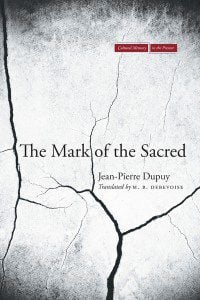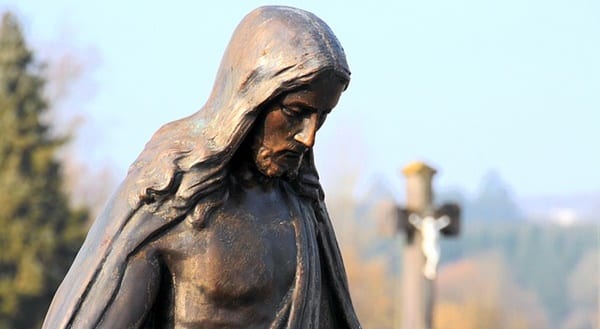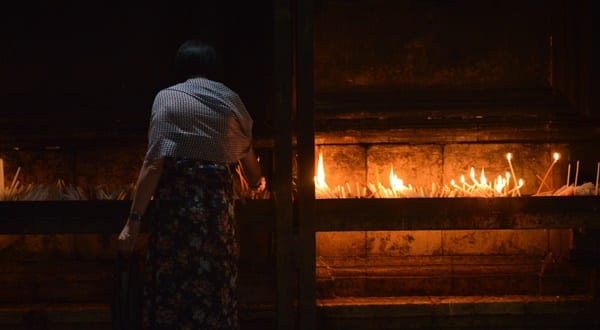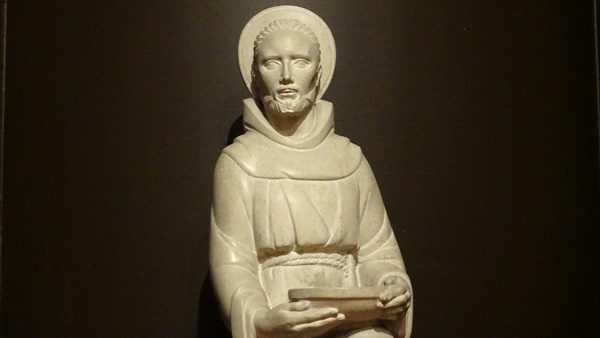 I want to discuss something fundamental, disturbing and largely invisible about human society that the ongoing events in Ferguson, MO are bringing into view. As you know, a young black man, Michael Brown, was shot dead by a uniformed police officer this past August and a Grand Jury decided not to indict him for murder, voluntary manslaughter or involuntary manslaughter. They decided that Brown’s death was a regrettable but justified killing while Brown’s family and supporters insist that it was just plain murder. Of course, Michael Brown is dead no matter how you classify what happened to him and so the persistent arguing about whether or not his death was caused by criminal behavior is a sideshow to the main event: all human societies since the beginning have used “good” violence to control “bad” violence. The effort to maintain the illusion of this false difference is unraveling before our eyes and with it the very foundation of human community. If you think there’s a lot at stake in this case, you are more right than you know.
I want to discuss something fundamental, disturbing and largely invisible about human society that the ongoing events in Ferguson, MO are bringing into view. As you know, a young black man, Michael Brown, was shot dead by a uniformed police officer this past August and a Grand Jury decided not to indict him for murder, voluntary manslaughter or involuntary manslaughter. They decided that Brown’s death was a regrettable but justified killing while Brown’s family and supporters insist that it was just plain murder. Of course, Michael Brown is dead no matter how you classify what happened to him and so the persistent arguing about whether or not his death was caused by criminal behavior is a sideshow to the main event: all human societies since the beginning have used “good” violence to control “bad” violence. The effort to maintain the illusion of this false difference is unraveling before our eyes and with it the very foundation of human community. If you think there’s a lot at stake in this case, you are more right than you know.
Taking Sides? Don’t Get Sucked Into a Sideshow
Good people began taking sides on Michael Brown’s death within minutes, perhaps even as the events unfolded. Was Mr. Brown crazed and aggressive, “a demon” threatening Officer Darrin Wilson’s life as Wilson described in Grand Jury testimony? Or is Wilson the aggressor, blinded by racism into seeing a threat where none existed? Look, it’s easy to make a case for either side. The release of all the Grand Jury evidence by the prosecutor is an empty gesture. Each side will find ample evidence to support their view of what happened, so let’s move to a deeper analysis. The very act of taking sides is a sideshow, if you’ll excuse the pun, to the more fundamental issue here: the way human communities dress up violence as necessary and good in order to protect ourselves against, well, against our own violence.
In a work of breathtaking clarity, philosopher Jean-Pierre Dupuy uses the mimetic theory of his mentor and colleague René Girard to make a startling claim about humanity’s dependence on violence to establish and maintain order. In his book The Mark of the Sacred, Dupuy explains that human civilization was made possible by creating a category of “good” violence and attributing it to the gods. What Dupuy and Girard call the realm of the sacred is a ritualized mechanism in which violence is used to contain or limit itself. You see, then as now, the biggest threat to the survival of human community is not some outside danger, but our own tendency to turn on each other in self-destructive violence. As we see in Ferguson, MO now, the threat of violence is everywhere exposed and it is one that arises from within. The “good” violence of the state in the form of the National Guard is attempting to re-assert itself to contain the “bad” violence of looting and rioting. No outside enemies are to be found here. Just a community at war with itself.
In the ancient world when human sacrifice was the heart and soul of civic life, the sacred realm was ruled over by priests. By cloaking human sacrifice in the sacred, sacrificial rituals galvanized communities around the altar and blinded them to what we can so clearly see: that the act of sacrificing a victim to the gods is not sacred but murder, plain and simple. Today we would call the victim a scapegoat, made to take the blame for all the ills of the community and sentenced to death. As Dupuy explains, “sacrifice contains the outbreak and spread of murder; though it is in one sense just another murder, it promises to put an end to violence.” (5)
In discussing this “disconcerting kinship of violence and the sacred,” Dupuy makes two observations:
It is easy to mistake two things here. The first error consists in not seeing that sacrifice rests upon murder – a relationship that all religious thought works to conceal. The second, and converse, error consists in simply asserting the identity of sacrifice and murder… without taking into account the difference between the two acts – a difference that lies at the very source of civilization. (101)
The difference, of course, is that the killing of a sacrificial victim is cloaked in the aura of the sacred while murder is not. It is the ability to turn plain and simple murder into a divinely sanctioned act that transforms violence itself from something evil and destructive into something good and constructive of everything we know as civilization today. What we cannot see when we are in the thrall of the sacred, is that the one we believe is irredeemably evil and deserving of our violence is in fact a scapegoat, falsely accused and underserving of our wrath. In the case of Ferguson, sides are aligning around accusations of blame against either Brown or Wilson. In so doing, they are creating a sense of purpose and community over and against their adversaries. It may be that Brown and Wilson are each deserving of both blame and mercy, though there is little room now to contemplate such a paradox. In other words, by “taking sides” we are choosing scapegoats rather than honestly engaging with the complexities of humanity’s addiction to violence.
Appeasing Anger, Averting Violence
How does this difference between ancient sacrifice and murder become the “very source of civilization”? Well, sacrifices were thought to appease the anger of the gods and keep their violence at bay so as to protect human communities from their destructive fury. The truth, however, is that it was not the gods’ anger that needed appeasing, but the anger of community’s members toward one another. It was not the gods’ violence that threatened to destroy a community but the real risk was from human anger turning violent and destroying the community from within.
Rituals of sacrificial violence successfully projected the anger and violence outside the community, packaged it as a public good, and so managed to use the sacrificial violence to cathartic effect. A small dose of controlled, sacred violence protected the community from its own tendency to erupt into uncontrollable spasms of violence.
In our day, the new priests are the bureaucrats of our political/ legal/ judicial system. Their job is to shroud violence with a sacred aura, package it as a public good and maintain the utterly false distinction between a justified killing and murder. The announcement of the Grand Jury’s decision by the St. Louis County Prosecuting Attorney, Robert McCulloch was an exemplary performance of this sacred duty. Our new high priests have offered many statements condemning the violent protestors as a threat to the public good while defending state (i.e. sacred) violence. I offer one particularly vexing example. In Chicago, President Obama recently denounced the riots as “criminal acts that should be prosecuted.” How glibly he condemns one kind of violence while justifying others; without any moral qualms he calls the destruction of property in Ferguson a criminal act but the destruction of property in Iraq and Syria by U.S. bombs regrettable but justified. What is becoming harder to deny is that despite promises to the contrary, the use of “good” violence in Iraq, Afghanistan and Syria is an exercise in futility.
Unfortunately for our world, our leaders, the media, and the general public are all caught up in the self-defeating paradigm of sacred violence. All we seem able to do is to channel our violence into a condemnation of our adversary’s violence, shroud our violence as a sacred good, and hope that peace can be restored. As we are seeing in Ferguson and throughout the Middle East, the peace bought through violence is doomed to repeated failures requiring ever more infusions of “good” violence until the distinction crumbles in hypocrisy.
Violence is Not the Answer
Just as the ancient world lost their faith in the goodness of human sacrifice, so today we are losing our faith in justified violence. The false difference between murder and justified killing is evaporating and no amount of appeals from our modern priests can re-convince us that the difference is real. We need to find another way to create and maintain the peace of our communities that condemns all violence for what it is: violence. We must not only condemn the violence of our adversaries, but realize that we fall under the same condemnation. All violence is evil, all killings are murder, and the realm of the sacred is nothing more than a delusion shared by all of humanity.
Predictably, the realm of the sacred will not go down easily and will thrash violently against any attempt to destroy it. Which is why we see increasing uses of violence both domestically and abroad even as the futility of violence is becoming harder to deny. As we persist in using sacred violence to achieve peace, despite evidence that it only yields more violence, we begin to resemble the definition of insanity offered by Albert Einstein: doing the same thing over and over again expecting different results. As I said, the events in Ferguson reveal that we are in more dire straights than we realize.
I’d like to close with a few voices from outside the realm of the sacred from those who are calling for an end to the use of violence under any circumstances. Poignantly, Michael Brown’s family issued this statement after the Grand Jury verdict:
We are profoundly disappointed that the killer of our child will not face the consequence of his actions. While we understand that many others share our pain, we ask that you channel your frustration in ways that will make a positive change. We need to work together to fix the system that allowed this to happen… We respectfully ask that you please keep your protests peaceful. Answering violence with violence is not the appropriate reaction. Let’s not just make noise, let’s make a difference.
The Brown family is pleading with us to find another way to live peaceably together that does not involve us justifying our violence. Of course, they are echoing another victim of violence, Jesus Christ, who, from the cross, pleaded with his Father for the forgiveness of his persecutors. He returned with the marks of his persecution on his body, offering mercy not vengeance. His was not an attempt to excuse or justify violence, but simply a statement of truth: justifying violence will never end violence. It only perpetuates it perhaps to the point of apocalyptic self-annihilation. Only when good people stop justifying their violence as “good” will we be able to end the scourge of violence once and for all.
I’d also like to offer you the words of my dear friend and colleague, Adam Ericksen, who is engaged with his own effort to resist the despair that has overtaken him in the face of the violence in Ferguson. I hope we can find the courage to resist taking sides and instead examine our own complicity in a world addicted to scapegoating and sacred violence.
Ending the cycle of blame is the hope for our future. But will we stop that cycle and replace it with sacrificial love and forgiveness?
As I take a bird’s eye view and look into the pit of despair, I have my doubts. The ultimate prophetic warning that Christianity has to offer is that if we keep scapegoating one another, we will destroy ourselves in Apocalyptic violence to which the only alternative is nonviolent love and forgiveness.
René Girard put that prophetic warning best in his book Battling to the End, “Saying that chaos is near is not incompatible with hope, quite to the contrary. However, hope has to be seen in relation to an alternative that leaves only the choice between total destruction and the realization of the Kingdom” (119).
The realization of the Kingdom of God will only happen when we stop blaming one another. It will only happen when we realize that God loves all people, whether we think they deserve it or not. And it will only happen when we begin to take responsibility to love our neighbors as we love ourselves.
This Thanksgiving, I’m thankful that God is not a god of power and might. I’m thankful that the one true God is a God who meets us in our despair, who empowers us to stop scapegoating, and who is loving us with reckless abandoned.











